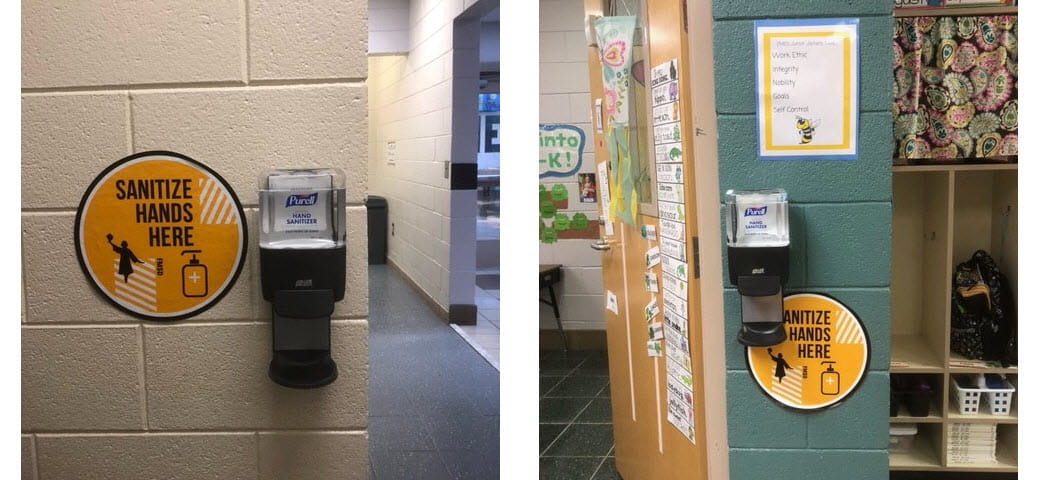Return to in-person learning with confidence by avoiding common pitfalls and providing optimal protection against germs that can cause illness
Is your school sitting on a glut of hand sanitizer purchased at the height of the pandemic? If you answered “yes” to this question, you are not alone. Most school districts have stocks of hand sanitizer, so believe they’re covered for a safe return to in-person learning. This may be true, however many of the products that schools stocked up on during the pandemic are not safe or effective. Additionally, many schools are “topping off containers” of alcohol-based hand sanitizer, which according to the CDC, poses a potential safety risk, such as inadvertent contamination or reduced efficacy due to alcohol evaporation.1
In this article, we highlight common problems and simple solutions related to providing safe and effective hand sanitizer in schools so you can reopen and stay open for in-person learning.
Why hand sanitizer remains critical in schools
With fewer schools requiring masks and more students expected to return for full-time, in-person learning, more respiratory droplets and germs can get onto surfaces and classroom objects and thereby the hands that touch them. So, it’s more important than ever that we get hand hygiene right. High-quality hand sanitizer helps to provide greater reduction of germs after handwashing and when handwashing isn’t convenient or available. Furthermore, scientists have now demonstrated that the addition of a high-efficacy hand sanitizer to a handwashing regimen can result in a greater reduction of germs compared to handwashing or sanitizing alone.
Check your hand sanitizer for safety, efficacy, and aesthetics
Most schools we talk with have an excess of hand sanitizer in their inventory that they purchased at the onset of the pandemic. The widespread availability of inferior and unproven products has led to concerns on safety, compliance, and overall germ-killing (or germ reduction) efficacy.
During the pandemic, the FDA temporarily allowed increased manufacturing of sanitizer to meet demand. However, concerns of contaminants, inadequate levels of active ingredient (ethyl alcohol or isopropyl alcohol), labels with false, or unproven claims have since surfaced, with more than 240 products now banned by the FDA.2
Furthermore, schools need to ensure that hand sanitizer aesthetics aren’t a deterrent to using it. In a recent survey of educators, almost half of educators responded they were unlikely to use a poor-quality hand sanitizer, with up to 70% reporting unlikeliness to use a sanitizer if it irritates skin, smells bad, or has a sticky consistency.3 In the same study, 73% of educators reported concern that students would not use a provided sanitizer due to poor aesthetic qualities.
When choosing a hand sanitizer, follow the guidelines below to ensure safe and effective products are available for use in your school district:
- Choose hand sanitizer containing at least 60% ethyl alcohol or 70% isopropyl alcohol for proven efficacy against germs.
- Ensure the product is in the original packaging with appropriate labeling and is not on the FDA banned list of sanitizers. Also check the product’s expiration date, which is based on the date of manufacture of that product. The safety and efficacy of the product can be guaranteed up to the expiration date.
- Avoid hand sanitizers with poor aesthetic qualities, such as an undesirable smell, product consistency, stickiness, or those that irritate or dry hands.
- Avoid mixing sanitizer formulations and the use of top-fill sanitizer dispensers to ensure the safety and efficacy of the product are not compromised.
- Consider optimal placement of hand sanitizers near high traffic areas and outside restrooms and cafeterias.
Best Practice from a Top District
Fort Mill School District in South Carolina was like many schools – they purchased hand sanitizer during the pandemic, what they could get their hands on – and quickly realized that students, teachers, and staff were unhappy with the product and weren’t readily using it. Like many schools, the hand sanitizer Fort Mill purchased had poor aesthetics – thick, sticky, and had an unpleasant odor. Plus, the alcohol content was too high, and the school was at risk of exceeding the fire code alcohol limit with the jugs of hand sanitizer.
“The safety and health of our staff, students, and visitors have always been one of our top priorities,” said Jay Taylor, maintenance director at Fort Mill School District. After receiving complaints about the hand sanitizer, the team began to evaluate safer, more effective hand sanitizers. “PURELL seemed to be something many of our folks knew and liked,” said Taylor.
Today, Fort Mill School District has PURELL® brand hand sanitizer dispensers installed in every classroom, common area, and office district-wide (see photos below). “We wanted to provide PURELL in as many areas as possible to continue to make our schools safer,” said Clint Brower, custodial support specialist, Fort Mill School District.

Brower and the crew at Fort Mill also like that the PURELL® systems have cartridges that can be easily replaced when the product runs out. A smart move by his team since PURELL® hand sanitizer refills are SANITARY SEALED™, so they don’t pose a contamination risk like many of the top-fill hand sanitizer systems. Plus, “There has been nothing but positive feedback from our students, staff, and visitors,” said Brower.
For more information and useful tips on reopening your K-12 facilities safely, visit the PURELL® Brand K-12 Well-Being Center.
Additionally, check that your hand sanitizer and practices are safe by checking these links to the FDA hand sanitizer recalls and the CDC top-fill or bulk hand sanitizer guidelines:
FDA recalls,
ban on ABHS imported from Mexico, and
CDC bulk sanitizer guidance.